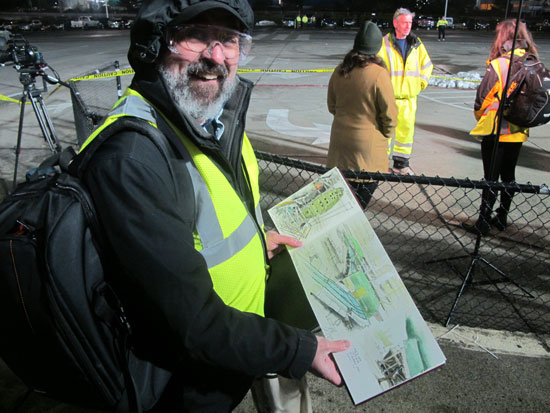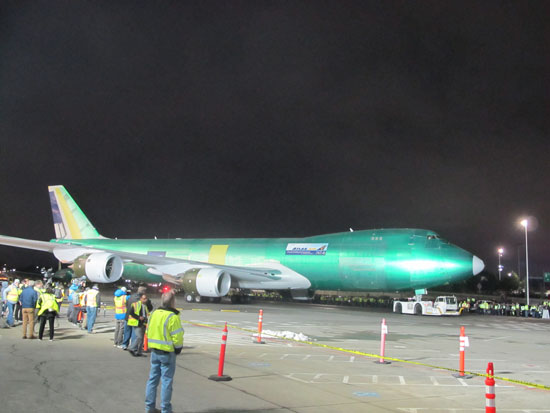The final Boeing 747 begins to peek out from the factory floor as a tug pulls it Dec. 6.
Photo by Michael Whitney.
EVERETT — It was a 747's welcome to the world that marked the end of an era Dec. 6.
On a crisp, cool night, 747 No. 1,547 rolled out of the factory, a 747-8F in gleaming green coating, before an adoring congregation of Boeing workers who gave a rousing cheer.
It's destined for cargo duties with Atlas Air, who ordered the last four 747s in 2021.
"It's one of those bittersweet moments," said Ben Roehl, of Arlington, as people awaited it to come out. Roehl spent 15 years with the 747 in caulking and sealing, and also works on the 767. The wings of a 747 are much more spacious to work inside. "I thought it was a beautiful airplane."
Like a newborn, this is the first time it's been outside, remarked 747 Production and Manufacturing superintendent Steve Kopecki.
At the event, a few wore high-visibility jackets with the words “Last of the Queen of the Skies.”
David Bruton, a Boeing assembler from Snohomish, came to see the end. “That’s it,” he said.
He said he was here in 1969 at the 747’s first-flight watch party in Mukilteo, and he wanted to be sure to witness this moment in history.
Pulled by tug, the last 747, tail number N682GT, went over the Boeing Freeway bridge to be stationed for its first test flight in the coming weeks. It will get its livery paintjob and be delivered in the first few months of 2023, said Jessica Kowal, a spokeswoman for Boeing Commercial Airplanes.
Atlas named the plane “Empower,” and will operate it on behalf of the Swiss-based freight transporter Kuehne+Nagel, according to an Atlas Air press release.
A corps of 100 were dedicated to building this last 747, said Brianna Jackson, 747 communications manager.
With 55 years of history, many are legacy workers. Their parents worked these planes, Jackson said.
Seeing the last 747 “is very personal to a lot of our employees,” Jackson
said.
Everett owes the 747 some gratitude.
The company chose Everett after weighing where to place the 747.
The Boeing Everett plant was built bespoke for the 747. In 1966, Boeing took hundreds of acres and built the plant near existing Paine Field.
Sixteen months later, a team nicknamed The Incredibles finished 747 No. 1, which after debuting with Pan Am now is on display at the Museum of Flight in Seattle.
Powerful, and big, the jumbo jet with the unmistakable hump had a distinct role to play for Boeing. Since then, 747s have carried presidents, ferried the Space Shuttle, and everything in between.
Boeing senior historian Michael Lombardi said the 747’s role in Everett is something to think about. “I get a tear in my eye.”
What’s next at the plant?
Boeing Everett builds the 767, 777 and 777X, plus the KC-46 tanker military derivative of the 767, and a freighter 777X is in the pipeline.
Hyper-efficient 777X passenger planes could be in airline fleets by 2025. Production was paused, but should restart in 2023, Kowal from Boeing said.
Tougher emissions limits for all brand-new planes built Jan. 1, 2028 onward may force retiring the 767 and could ensnare the original 777 as well.
But by then, a 777X-based freighter in Everett, the 777-8F, is scheduled to start by 2027, said Jim Proulx, a spokesman for Boeing Commercial Airplanes.
Over the year, 747 workers have been reassigned to other plane models in the factory.
“There are no employment reductions expected as a result of 747 production closeout,” Kowal said.
Boeing is mum as to what will take over 747’s factory floor space in Everett. Right now it will be under construction for its next role, Proulx said. Proulx couldn’t say for what except that the Everett site is committed to widebody planes. This quashes that a 737 line would start in Everett. Narrowbody 737s are built at its Renton plant.
The 787 is built in South Carolina, but Everett workers are currently reworking some undelivered 787s for precision fitment work to fix “paper thin gaps,” Kowal said.
No 787-based freighter has been announced, but aviation trade journalists presume one is widely expected.
And CEO Dave Calhoun officially told investors last month that plans for its New Market Airplane are off the table. This is the one people nicknamed the future “797.” It was a midrange plane bigger than the 737 and smaller than the 787 idealized as the 757's and 767’s replacement.
 Michael Whitney photo
Michael Whitney photo
Why retire the 747 at all?

 Michael Whitney photo
Michael Whitney photo